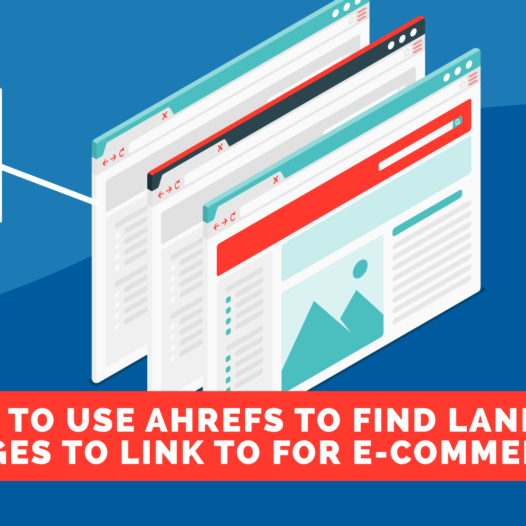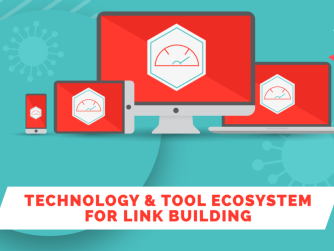Content marketing is a go-to tactic for many websites. But it’s not always the best fit for eCommerce sites. SEOs and digital marketers may struggle to identify link opportunities for commercial pages.
Selecting eCommerce landing pages is a major challenge. It can be difficult to decide when to link to your home page, a category page, bor a specific product page.
Acquiring links to product and category pages is important for top rankings and improving sales, particularly when there is active competition. Links to the home page just aren’t always enough.
A study of over 11.8 million google search results found the number of referring domains pointing to a page correlates with ranking.
Securing backlinks to the proper pages is essential to a successfully ranking eCommerce category and product pages.
This guide teaches how to choose the right commercial pages for link building.
How Does Page Selection Fit into eCommerce Link Building?
Like any other type of link building, the landing page influences the location, context, and anchor text of the backlink. That means it may be wrong to use a specific anchor text like “shop hoodies” if you intend to link the home page of a general clothing retailer.
The anchor text creates an expectation of what they will find when they click a link. So it’s important that the anchor text describes the page or content it is pointing towards.
Commercial landing pages require backlinks from a variety of content types. While product comparison blogs and how-to articles may link to specific product pages, general advice columns might be a better fit for linking to category pages.
An eCommerce marketer should be comfortable working with different content types to build a robust backlink profile for their site. Industry roundup articles, infographics, resource pages, and even specific brand mentions can all provide opportunities for commercial backlinks.
eCommerce link builders should also use a wide variety of anchor text. A commercial anchor text should be selected carefully. It can include the name of the brand, the specific product, or a general phrase.
For effective commercial link building, the landing page, anchor text, and referring content must all be informed by the user’s search intent. In other words, you should choose the landing page based on what the reader wants to learn (product research) or what they need (to buy). Is the content where the link is relevant to consumers looking for general information about how the product is used, or is the context more suited for people who are prepared to make a purchase?
Your success in commercial link building will be determined by how well you can match the link and landing page to the user’s search intent. With practice and research, you’ll be able to support even your most technical, unsexy product pages with an array of relevant backlinks.
Three Types of eCommerce Landing Pages
Most commercial pages fall into three main types:
- Home pages
- Category/brand pages
- Specific product pages
Home pages are the face of the business. These pages tend to focus on introducing the brand rather than any specific product. A successful home page uses a pleasing design to quickly convey what the brand sells, who it sells to, why it is trusted, who trusts the brand and how it outperforms competitors.
Home pages should include clear calls to action to help funnel visitors toward sales opportunities.
Category pages are the virtual aisles of an online store. They contain grids or lists of many products/brands for shoppers to search through. The best category pages keep the website organized and help visitors find products.
Product pages. When a viewer clicks on an item from a category page, they are directed to a product page where they can find:
- Reviews
- Images
- Detailed specs
- FAQ (Frequently Asked Questions)
- Comparisons with similar products
- Pricing information
Product pages should provide visitors with all the information they need to help them make an informed purchase decision.
A well-organized eCommerce site leads visitors through the buying process, helping them find information and the right product for their needs. Often, this guidance can be created through internal link architecture.
Establishing a logical flow of internal links between your home page, category pages, and product pages passes along SEO authority to each. This tactic ensures that earning a backlink to one page helps bolster the rest of the site.
How to Choose the Right Type of Landing Page for Links
Choosing the right landing page can be the difference between securing a link or wasting countless hours on backlinks that don’t help at all.
Here is how to choose the right landing page for your SEO goals.
Linking to the Home Page
Ideal Content
Technically, the home page is not commercial— it’s more of a general information page that showcases your brand as a whole. As such, it’s best to place homepage backlinks in general content. Trend pieces, news stories, roundups, listicles, and casual blogs all offer opportunities for home page links.
Strategy
When writing content for a home page backlink, your goal should be to introduce your brand to new prospects. At this stage, your audience may not be looking to purchase something specific, but rather looking for topical information or just browsing. To get your home page in front of the right people, create content that your target audience would find interesting and generally helpful.
Techniques to secure homepage backlinks include:
- Help a Reporter Out (HARO): Journalist outreach and pitching of expertise and valuable content
- High-quality directories: Listing your site in niche directories that are topically relevant or have a related category
- Guest posting: Contributing to high-quality guest posting from company experts can yield bylines linking to a homepage
Your anchor text should reflect this general approach. Include your brand name or broad keywords that describe what a user might expect to find when they reach your home page (a furniture shop, women’s business wear, etc.).
Example:
Say you write for a website that sells handmade pottery. You could include a link to your home page on many lifestyle blogs, artist blogs, gardening blogs, and more. In a general advice blog, you could include a link to your home page in a sentence like this: “When choosing vases for your open-air shelves, check out companies like PotterySpot for color and design inspiration.” Place the link on the brand name so that readers expect to see your site when they click.
Linking to Category Pages
Ideal Content
For category page backlinks, you can target readers who may be comparing products and considering a purchase, or you can target people just exploring topics in your industry. Compared to homepage links, links to category pages should be placed in more industry-specific content, such as topical listicles, industry related blogs, and how-to guides.
Strategy
When building backlinks to category pages, keep in mind how detailed the visitor expects or needs the content to be. If you’re placing a link in a very niche page and the user would be ready to compare products for purchase, you can send them to a more specialized category page.
Category pages affords writers the opportunity to create natural eCommerce links in content that may not discuss a specific product. For category backlinks, marketers should optimize anchor text for topical keywords and match search intent with longer phrases. However, avoid product-specific keywords at this stage.
Example:
Let’s say PotterySpot is included in an article titled “7 Cheap Ways to Make Your Home More Unique” for a lifestyle or budgeting blog. One of the suggestions could be to pot houseplants in artisan planters, with “artisan planters” as the anchor text. None of the other items on the list need to relate to pottery at all, which is the advantage of category page link building— it works in many types of content, but can still convert sales.
In this scenario, linking to a product page for a specific planter wouldn’t be ideal. The reader would probably click away quickly because they were just looking for inspiration. However, if the reader was sent to a category page full of colorful, various plant containers, they may browse around to get more ideas and perhaps purchase an item.
Linking to Product Pages
Ideal Content
Product pages are the more specific commercial landing pages, and backlinks should come from industry/product relevant content. Review pages and comparison articles tend to offer the most natural backlink opportunities for product pages since they discuss the pros and cons of specific items.
Strategy
When building links to product pages, your target audience is already well-versed in the topic. They may be ready to make a purchase, and they likely want to gather as much information as possible.
Aim to anticipate and answer their product-related questions so that your brand stands out as trustworthy and informative. Your anchor text can be a very precise keyword or a specific product, such as “Nikon D3500 DLSR Camera.”
Example:
Instead of earning a link from an article about home decor for PotterySpot, you could obtain a link from a guide to selecting containers for your indoor plants. A link to a product page would make sense within paragraphs recommending the best material, size, and shape of the container based on the plant species. A link to a product page using a product or feature-specific anchor text, such as “self-watering ceramic planter” makes sense within that context.
In this example, the reader is probably knowledgeable about caring for indoor plants. They might be looking for specialized containers or a gift for someone else. Directing these readers to a product page with exactly what they’re looking for saves them time, and it helps PotterySpot to improve rankings and sales for that product page.
In general, choose your landing page based on what’s most convenient for the user. The faster they can find the information they need, the more often those inbound clicks will convert to sales.
Tools for Selecting eCommerce Landing Pages
There are many tools available to guide marketers through the link building process. When selecting eCommerce right landing pages, Ahrefs Site Explorer can be indispensable, especially if you have a large site and need help prioritizing or focusing your link building efforts.
Ahrefs Site Explorer can help you identify underperforming pages. Start by using the tool to sort your website by Top Pages by Traffic. This will give you a good baseline for understanding how your site is performing overall— you’ll be able to see which of your product pages and category pages are most successful, as well as pages that could use some work.
Next, use the report to determine what your main keywords are for each page. These keywords can help you find fresh link building opportunities, and oftentimes make a natural choice for your anchor text.
It’s important to establish a few KPIs (Key Performance Indicators) to ensure you’re selecting the most effective landing pages, such as a target conversion rate, views, and average time on the page. These metrics can help you decide whether to prioritize pages that are performing well to maintain their lead, or to improve pages that are ranking below the top positions to boost your presence on the SERP (Search Engine Results Page).
Since eCommerce link building is sales motivated, your KPIs will be determined by your team’s established sales targets. Be sure to monitor page performance regularly and adjust your link building strategy as necessary.
Let Your Audience Pick for You
When you’re having difficulty selecting a commercial landing page, take a step back. Look at your metrics, and try to get in the mind of your audience. When you focus on your user’s search intent, you can determine whether they’re looking for general or specific product information. Choose the landing page that makes the most sense for where each visitor is in the buying process.
If you’re still stuck, reevaluate your metrics to determine which links refer the most visitors, and consider your pages where visitors linger the longest. What makes this content so useful? How can you replicate its success? By listening to your audience, you’ll take the guesswork out of selecting eCommerce landing pages and create a link building strategy that converts.






